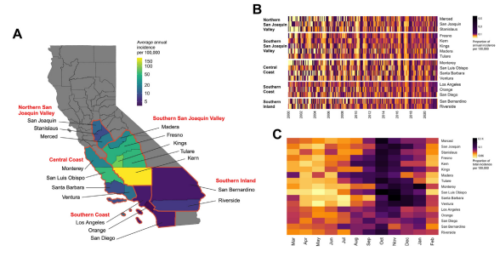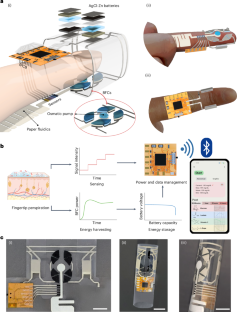2024-09-03 カリフォルニア大学サンディエゴ校(UCSD)
<関連情報>
- https://today.ucsd.edu/story/dangerous-airborne-fungus-boosted-by-california-droughts
- https://www.thelancet.com/journals/lanam/article/PIIS2667-193X(24)00191-1/fulltext
カリフォルニア州におけるコクシジオイデス症の季節性:季節性動態の気候決定要因と時空間変動に関する縦断的サーベイランス研究、2000-2021年 Coccidioidomycosis seasonality in California: a longitudinal surveillance study of the climate determinants and spatiotemporal variability of seasonal dynamics, 2000–2021
Alexandra K. Heaney, Simon K. Camponuri, Jennifer R. Head, Philip Collender, Amanda Weaver, Gail Sondermeyer Cooksey et al.
The Lancet Regional Health – Americas Published: August 19, 2024
DOI: 10.1016/j.lana.2024.100864

Summary
Background
Coccidioidomycosis, an emerging fungal disease in the western USA, exhibits seasonal patterns that are poorly understood, including periods of strong cyclicity, aseasonal intervals, and variation in seasonal timing that have been minimally characterized, and unexplained as to their causal factors. Coccidioidomycosis incidence has increased markedly in recent years, and our limited understanding of intra- and inter-annual seasonality has hindered the identification of important drivers of disease transmission, including climate conditions. In this study, we aim to characterize coccidioidomycosis seasonality in endemic regions of California and to estimate the relationship between drought conditions and coccidioidomycosis seasonal periodicity and timing.
Methods
We analysed data on all reported incident cases of coccidioidomycosis in California from 2000 to 2021 to characterize seasonal patterns in incidence, and conducted wavelet analyses to assess the dominant periodicity, power, and timing of incidence for 17 counties with consistently high incidence rates. We assessed associations between seasonality parameters and measures of drought in California using a distributed lag nonlinear modelling framework.
Findings
All counties exhibited annual cyclicity in incidence (i.e., a dominant wavelet periodicity of 12 months), but there was considerable heterogeneity in seasonal strength and timing across regions and years. On average, 12-month periodicity was most pronounced in the Southern San Joaquin Valley and Central Coast. Further, the annual seasonal cycles in the Southern San Joaquin Valley and the Southern Inland regions occurred earlier than those in coastal and northern counties, yet the timing of annual cycles became more aligned among counties by the end of the study period. Drought conditions were associated with a strong attenuation of the annual seasonal cycle, and seasonal peaks became more pronounced in the 1–2 years after a drought ended.
Interpretation
We conclude that drought conditions do not increase the risk of coccidioidomycosis onset uniformly across the year, but instead promote increased risk concentrated within a specific calendar period (September to December). The findings have important implications for public health preparedness, and for how future shifts in seasonal climate patterns and extreme events may impact spatial and temporal coccidioidomycosis risk.
Funding
National Institutes of Health.

